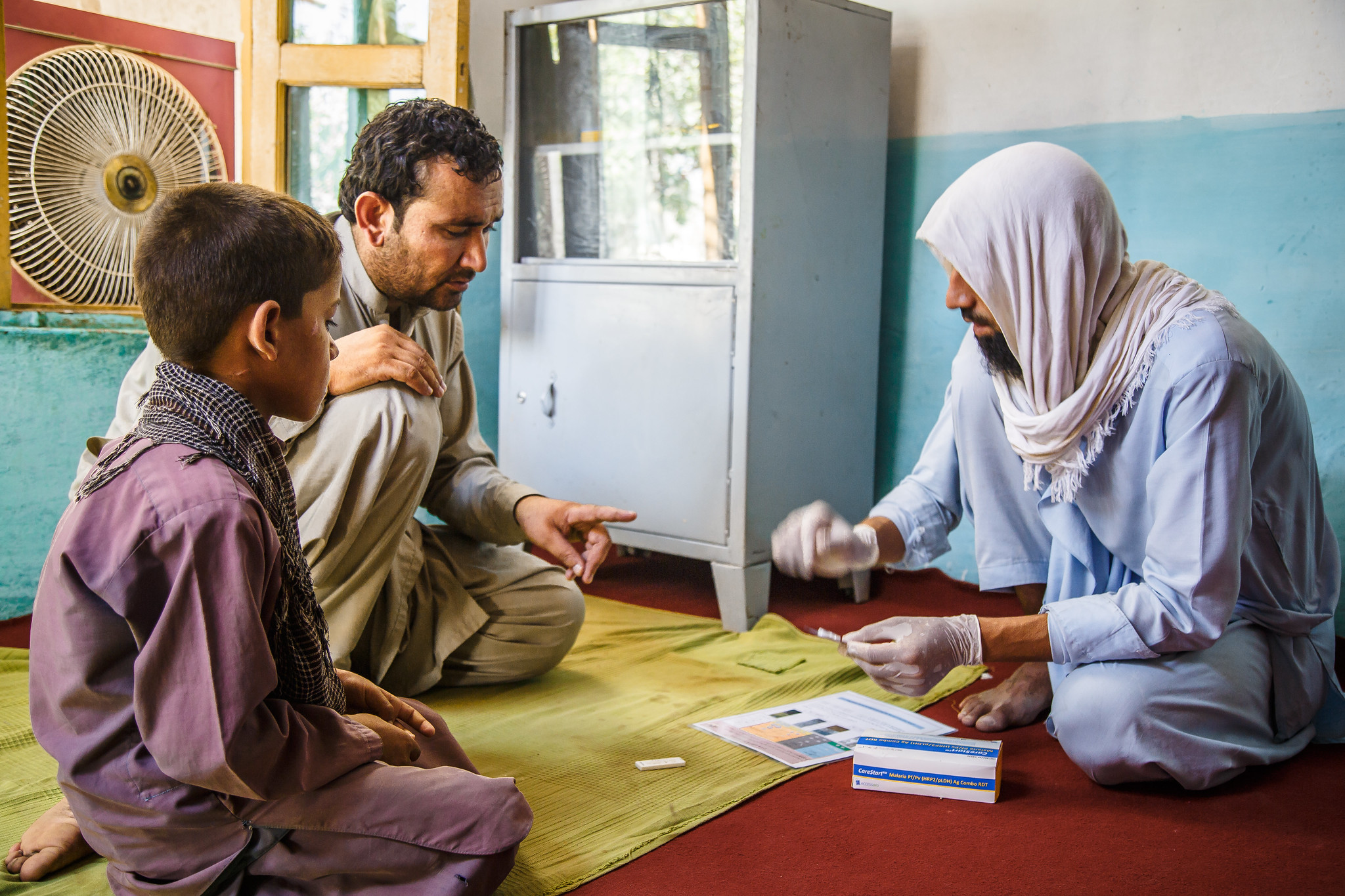How a Community-Based Strategy helped reduce Malaria in Afghanistan
January 31, 2024

Nooragha, a Community health worker in Beshsud district, near Jalalabad, provides 24-hour first aid support to the villagers.
Malaria is a deadly disease that affects millions of people around the world every year. In Afghanistan, malaria continues to be a public health problem. The transmission of malaria is seasonal, and its distribution varies largely from place to place, depending on a variety of factors related to parasites, vectors, and human populations under different geographical, ecological, and socio-economic conditions in the country. In Afghanistan, 27% of the population lives in areas at high risk for malaria, 50% at medium risk and the remaining 23% live in areas with no risk or very low risk of malaria transmission.
The Community-Based Malaria Management (CBMM) strategy, introduced in 2013 and expanded to all health facilities and health posts in Afghanistan by 2016, aimed to deliver rapid diagnostic testing (RDT) and more timely treatment to all communities nationwide.
The CBMM strategy was scaled up nationwide in 2016 with support from the United Nations Development Programme (UNDP) and the Global Fund programme. A main pillar of this strategy is introducing RDT in all health facilities, not only to those providing diagnosis and treatment for malaria and expanding screening of malaria to health posts to run community-based screening programs. The community-based malaria case management services were provided through an extensive network of community healthcare workers (CHWs), which has greatly enhanced the accessibility of patients with suspected malaria to case management services closer to home.
Since 2016, a network of 30,000 CHWs has been trained in malaria case management and RDT. Other malaria commodities such as medicine were supplied to all health posts and health facilities without laboratory services. As a result, more than 90% of the CHWs reported screening and referral of newly identified cases of malaria, and more than 50% reported providing counselling and chloroquine treatment to suspected and confirmed malaria cases.
The effectiveness of the CBMM programme in Afghanistan has not yet been evaluated. In this study, trends for several malaria outcome indicators were compared before and after the expansion of the CBMM strategy, using cross-sectional analysis of surveillance data. The trends in annual malaria incidence and death rates were assessed during two periods, four years before the expansion of CBMM (2012-2015), and four years after the expansion of the CBMM programme (2016-2019). The scope of the analysis included both national and subnational trends in Afghanistan.

A local doctor at Belandoghar community health centre, near Jalalabad.80% of Afghanistan’s malaria cases are in the east, which has more mosquitoes due to the humidity. Photo: UNDP / Omer Sadaat
The overall results showed that between 2012 and 2019, the total number of malaria cases (including clinical and confirmed) fell from 391,365 to 174,893. The overall malaria incidence rate declined from 15.4 to 5.5 per 1,000 per year, and the malaria confirmation rate increased from 14 to 99%. The number of malaria cases that were confirmed by testing rose from 54,840 to 173,859, and clinical cases declined from 336,525 to 1034. The malaria death rate fell from 0.14 to 0 per 100,000 per year.
These results are impressive and encouraging, as they show the impact of Afghanistan’s CBMM expansion to introduce rapid diagnostic tests and provide more timely treatment for malaria through all levels of care temporally correlates with significant improvement in multiple indicators of malaria control. The strategy also helped achieve some of the targets of the National Strategic Plan for Malaria 2018–22, such as reducing malaria incidence by 73% and increasing the proportion of confirmed malaria cases to 99%. The strategy has also been aligned with global goals such as the Sustainable Development Goals (SDGs) including good health and well-being; malaria elimination; and universal health coverage.
There were some challenges in this study, such as the quality and completeness of the data, the lack of individual characteristics and the private sector data, and the potential confounders that could affect the results. We also learned valuable lessons from this study, such as the importance of integrating the CBMM strategy with other interventions, strengthening the surveillance system, and adapting the strategy to the changing context of malaria in Afghanistan.

Zabihullah, a Tailor in Behsud district, near Jalalabad, sets up a bed net provided by UNDP/the Global Fund to protect his family against malaria. Photo: UNDP / Omer Sadaat
One of the implications of this study is that the CBMM strategy is a promising and innovative approach to improve the diagnosis and treatment of malaria at the community level in Afghanistan. The use of RDTs for the diagnosis of malaria could be best applied as a tool at the community level to facilitate the early treatment of malaria in settings where microscopy services are not available. The strategy has shown positive results in reducing malaria incidence and death rates and increasing malaria testing and confirmation rates. The strategy has contributed to the national and global goals of malaria elimination and public health. However, the strategy needs to be further evaluated and strengthened to address the challenges and limitations that remain. The strategy also needs to be scaled up and sustained to reach all the communities and people needing malaria care in Afghanistan.
In summary, the CBMM expansion which introduced rapid diagnostic tests for malaria to many primary care settings correlated with a significant increase in the number of confirmed cases, while also being correlated with a significant reduction in annual malaria incidence and death rates. The data and the study results corroborate similar studies that recommend community-based interventions as best practices for malaria control, especially in resource-limited settings.
If you want to learn more about the study, you can read the full article clicking here.

 Locations
Locations